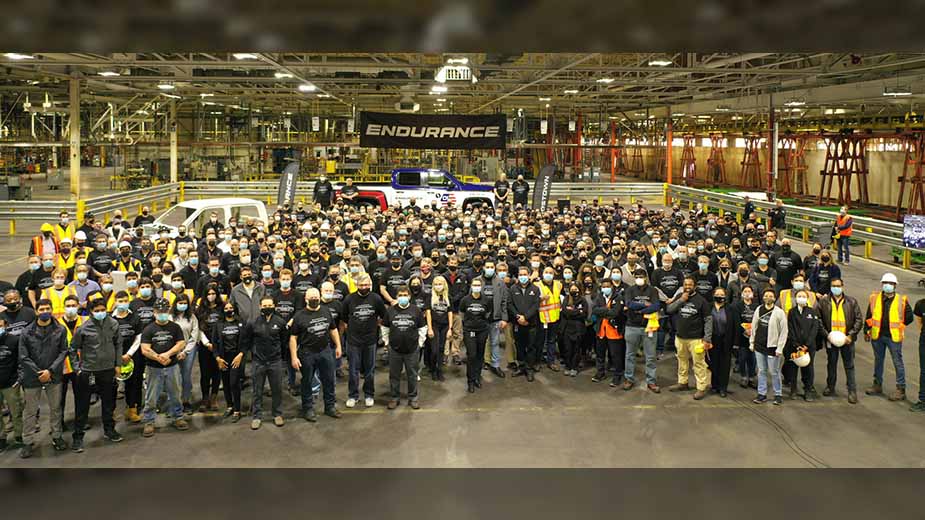LORDSTOWN – Lordstown Motors Corp. is quick to celebrate its successes. Right now, you might say it has no other choice.
The electric-vehicle startup announced April 1 the production of its inaugural beta models of the Endurance, and widely distributed video and pictures of the team and the two vehicles. The beta models – used mostly for safety validation purposes – rolled off the line on schedule as the company pushes toward the start of full production by the end of September.
The company flexed its public relations muscles further by showing off photos of the model it intends to run in the San Felipe 250 in Baja, Mexico, a rigorous off-road race April 14-18.
Even celebrity restaurateur and Ohio native Guy Fieri gave the nascent automaker a shout out on Twitter April 7. “Congrats on the betas and good luck at Baja,” Fieri tweeted.
While hitting these milestones is important for the company, it’s also a part of an effort to disarm skeptics in the wake of a damaging short-seller’s report, a handful of class action investor lawsuits, suffering stock value, and vigorous competition in the EV market.
General Motors announced April 6 its plans to produce an all-electric Silverado pickup to fill the EV space – one that will place the automaker in direct competition with Lordstown Motors (See story page 32). Ironically, GM holds a small equity stake in the startup, and it just might be in GM’s best interests for the Endurance also to succeed because of a complicated deal the two automakers agreed to last year.

On the legal front, the latest salvo comes from a class-action lawsuit filed in U.S. District Court April 2 that echoes a report by short-seller Hindenburg Research released March 12. That report alleges Lordstown Motors deceived shareholders by pumping up its more than 100,000 nonbinding letters of intent for the new vehicle as “pre-orders.”
Significantly, this lawsuit also contends that some of Lordstown’s directors and executives cashed out some of their shares, raking in nearly $27 million when the stock’s prices were strong – and “artificially inflated” – according to court documents.
“Defendants engaged in a scheme to deceive the market and a course of conduct that artificially inflated the prices of Lordstown common stock and operated as a fraud or deceit on purchasers of publicly traded Class A common stock,” the suit states.
The claim, filed on behalf of investor Sulayman Zuod, names as defendants Lordstown Motors, its CEO Steve Burns, President Rich Schmidt, Chief Financial Officer Julio Rodriguez, and Michael Fabian, director of stamping operations.
According to documents filed with the Securities and Exchange Commission, five executives and one director of Lordstown Motors shed nearly $27 million worth of stock between Oct. 22, 2020, and Feb. 4, 2021.
Among those selling was David Hamamoto, a director at Lordstown Motors and former CEO of DiamondPeak Holdings Corp., the special purpose acquisition company that took Lordstown Motors public on Oct. 22. That day, Hamamoto sold 1 million shares at $16.38 per unit for a total of $16.38 million. A footnote in a regulatory filing describing the transaction shows that the shares were sold to trusts established for family members.
Schmidt, Lordstown’s president, jettisoned more than $6.38 million worth of stock over four transactions between Dec. 12, 2020, and Feb. 3, 2021, SEC documents show. Another executive, Chuan Vo, vice president of propulsion, sold shares valuing more than $3.1 million between Dec. 14, 2020, and Feb 2, 2021.
Other executives such as chief production officer Shane Brown cashed out $465,886 worth of stock. Rodriguez, the company’s chief financial officer, sold shares worth a total of $251,100, while Darren Post, Lordstown’s chief engineer, sold shares valued at $272,100, documents show.
The legal complaint alleges that certain senior executives and directors “cashed in, selling more than 1.5 million of their personally held shares of Lordstown common stock at fraud-inflated prices and reaping almost $27 million in proceeds.”
After Hindenburg released its report March 12, Lordstown’s stock value plummeted by 16.5%. The stock suffered another setback when it was revealed that the U.S. Securities and Exchange Commission had requested documents and information from the company related to its pre-orders and its merger with DiamondPeak Holdings Corp.
The stock, which trades under the symbol RIDE, has since struggled to regain footing but appears to have stabilized. At the end of regular market trading April 8, Lordstown Motors’ shares closed at $12.32, up nearly 5% from the previous day’s close. The stock is still down 61.2% from its 52-week high of $31.80.
The lawsuit filed April 2 is similar to two earlier class action complaints filed against the company in March, and a fourth lawsuit filed April 8.
Lordstown Motors is also dealing with a civil lawsuit filed against it by DTE Lordstown in Trumbull County Common Pleas Court for breach of contract, and a court action brought by Karma Automotive in U.S. District Court in California alleging Lordstown Motors pilfered trade secrets related to Karma’s infotainment system.
At the heart of Lordstown’s latest issues is the Hindenburg report, which alleges the 100,000-plus orders Lordstown has boasted about are “largely fictitious.”
Lordstown Motors has yet to fully refute the report, although it promised to do so in a statement released shortly after the document was published.
During a call with analysts last month, CEO Burns said he could not address the Hindenburg analysis, nor was it mentioned in the company’s annual report. He indirectly touched upon it during a press event at the Lordstown plant.
“Whatever anybody thinks of us in the world, the main thing is we are going to be the first electric pickup truck in the United States, full-size, and that starts in September,” he said. “Haters are gonna hate.”
Among challenges confronting the startup is a crowded EV field that is growing more competitive. Over the last year, established automakers have said they will launch their own all-electric pickups.
Burns has said that Lordstown Motors has the edge since the Endurance would first be made available to fleets only, not directly to consumers. Plus, he’s emphasized that the company is working out of an existing plant it purchased from General Motors in November 2019.
That deal with GM provided Lordstown Motors with an intact plant and equipment, plus a $50 million line of credit GM extended to the company. GM kicked in another $25 million in cash when Lords-town Motors merged with DiamondPeak. GM’s total investment in the company yielded a 4.5% equity stake in Lordstown Motors.
Even so, some of the stiffest competition for Lordstown Motors is likely to come from GM itself.
The Detroit automaker said it would build the electric Silverado based on its Ultium battery cell technology at its Factory Zero plant near Detroit. The company has not announced when it would begin production of the Silverado but did specify it would be built for commercial and consumer use.
So, why would GM devote millions of dollars to a company it plans to compete against?
Part of the answer is tucked away inside
Lordstown Motors’ 10-K filing issued March 24.
The company disclosed in its report that it had entered into an agreement with GM in August 2020 in which GM would have an option to purchase discounted emissions credits from Lordstown
Motors during its first three years of production. Under the deal, GM is allowed to buy emissions credits at 75% of their market value from Lordstown Motors.
Automakers buy and sell emissions credits as a result of the U.S. Environmental Protection Agency’s “cap and trade” policy. Under this program, automakers are limited as to the amount of emissions they can expend. However, when these companies reach their limit, they can purchase credits from other automakers that would allow them to exceed these caps.
Thus, GM has the option to purchase Lordstown’s credits at a discounted price and then sell these credits on the market at full value, potentially reaping a tidy revenue stream. Or, it can use the credits to expand production of its emissions-heavy automobiles as it marches to its zero-emissions goal in 2035.
The catch is that in order to purchase these credits, the Endurance must be produced.
According to Lordstown’s Burns, that’s on track to happen and he’s convinced demand for the vehicle is solid, despite skeptics.
“We’re prepared to get all the way to the Promised Land with the demand we have,” he said.
Pictured: Employees at Lordstown Motors rally around the first two beta models of the Endurance, billed as the world’s first all-electric pickup.
